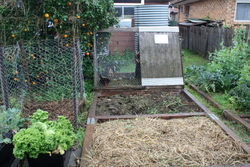
I had raised a batch of chicks to where they could live outside by themselves and I needed somewhere to put them. I wanted to put most of the existing chook run and its 20 years worth of manure into veggie production and, at the same time, ensure that the new fertilizer was more easily distributed among the other veggie patches.
I had come across the idea of the chook tractor, originated by Bill Mollison of permaculture fame, some years ago and even bought a book on them, but never really thought that I would get around to it. After careful thought, I found the idea of the chook tractor had a number of advantages over my current system –
1. Segregation – I could separate the new younger chooks from the older ones, preventing any crossover of disease.
2. Food efficiency – some of the chook food was pinched by ##@&*$ pigeons, so enclosing the chooks would fix their little red wagon!
3. Security – The tractor is almost escape proof, the current system allows the chooks to get out if they realize that they can fly over the fence.
4. Nutrient harvest – The chook poo goes exactly where you want it – onto the veggie patch – where my current system means that the harvest is difficult and incomplete.
5. Cultivation – the chooks dig up a small area repeatedly, eating weeds and pests in the process.
6. Aesthetics – The old chook shed/pen had gotten to be pretty much of an eyesore and a new, well made chook tractor would look much better.
7. More land, which could be returned to useful production.
With all these reasons why, I just HAD to build one!
I needed to work out a design for it and spent some time agonizing over the form it should take, intending to draw up plans to build it from. After supreme procrastination, I decided just to go ahead and build the damn thing!
I had an old pine bed base that was due for the scrap heap, and so used that as the raw material for the structure but needed to get hold of some plywood to make the sides. I still had some chook wire hanging around and some lengths of dowel I could use for perches so I was pretty good to go.
I decided to make it an A-frame shape for no better reason than I liked the look of it, the base being about 2 metres long by about 1.2 metres wide and the sides being about 1.6 metres wide giving the whole assembly a height at the apex of the A-frame of about 1.4 metres. One end and one half of the tractor were covered with plywood sides to provide shelter from the weather and a roosting area under cover and the other half and end was covered with chook wire for ventilation and sun.
About half way up the closed end I put in a shelf as a laying area for the chooks and the enclosed and had two full-width doors built in, the top one giving access to the laying area, the bottom one giving access to the rest of the chook tractor including the food and water dispensers, which were hung from the bottom of the laying area floor. There would be no floor on the tractor, of course, to allow the chooks to scratch, dig and destroy to their hearts content……….within the confines of the tractor!
Construction begins!
I cut up the main bearers of the bed frame to make the 2m x 1.2m base of the tractor and screwed it together. Next I grabbed six of the slats and cut the ends off at an angle so that they would form the uprights of the A-frame, one set at each end and one in the middle. I used another of the slats to form a ridge timber at the apex of the A-frame, and then screwed all of the timbers together, forming the basic frame of the tractor. To strengthen the A-frame I put a small triangular gusset of plywood on the outside top of each of the end A-frame. 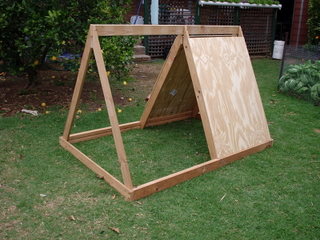
To form the roosting area I got hold of some plywood (exterior grade) but I didn’t have enough to go all the way down to the base, not to the top of the A-frame so I screwed it onto the uprights leaving a bit of clear space at the top and bottom, then bought some “Miniorb” corrugated iron with small corrugations from Bunnings and cut it to size with my angle grinder. I bent one piece over the top of the A-frame and screwed it to the plywood, forming a water-tight cover and screwed the two other pieces to the frame on one side and the plywood on the other, finishing off the covered area. To make the initial bend was easy but it needed to go over to quite an acute angle to cover the top of the A-frame so in the end I had to jump on it to get it to fit!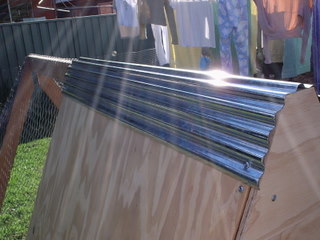
I put a brace cut from one of the slats on the covered end of the frame and screwed it into place, I put handles on it and it would be one of the lifting points for transporting the tractor between veggie patches. I then cut some more of the exterior grade plywood to make the large lower door and the smaller upper door giving access to what would be the laying area. 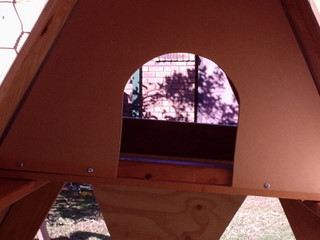
I had some 12mm thick MDF (medium density fibreboard) so I made the floor of the nesting area out of that, screwed on a support on each side of the plywood walls and then screwed the floor onto the supports. I originally made a sort of cut-out door area to screen off the laying area a bit (visible in some of the photos) but after having troubles enticing the chooks into the laying area I removed it and never bothered to put it back on. The laying area only took up about half the length of the covered in space, so I screwed in two lengths of dowel across the A-frame onto the support timber to act as roosts. The chook tractor originally had 6 chooks in it and the size of the roosts seemed to do the trick.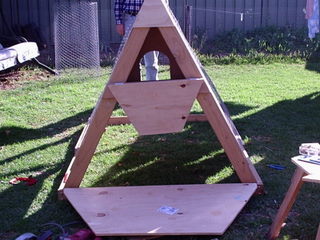
Returning to the “back doors”, there are times when my woodworking skills ……….ahhhh, leave a bit to be desired, so when I measured up the open end to make the doors I found that the angles were a bit off and had to specifically cut the doors to fit the measured opening, rather than what the opening was intended to be. The moral here is, as always, measure twice – cut once, not vice versa! I had some mild steel hinges and used these to hinge both doors so that they opened down. While the system worked, it was a pain to use if the covered end of the tractor got too close to a tree or fence or other obstruction. I used a magnetic catch to secure the top door, the smaller of the two, but when I tried the same trick with the bottom larger door, there was too much mass to be restrained by the small magnets so I wound up opting for a hook and eye system. I only put a hook and loop on one side but it worked pretty well. 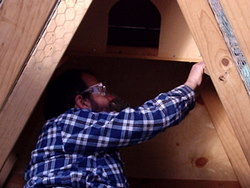
It was a simple matter to drill two holes in the floor of the laying area and install two eye bolts side by side so that I could hang a water container off one and a feeder off the other. All that remained was to cover the open end of the tractor in a layer of chook mesh and I did that by first folding a sheet of mesh the right size over the top and then screwing it to the inside of the plywood covering and the bottom base. I then cut a sheet into the shape of the A-frame end but leaving it a little oversized, I secured it by placing it against the open end and folding the protruding wires over the chook wire already in place on the A-frame. Once the wire was secured I screwed in a handle on each of the uprights at the open end to form the other lifting point for moving the tractor.
To finish off I did lacquer the plywood sides but I didn’t apply any form of coating to the rest of the tractor. It did its job very well but was somewhat over designed and rather heaveeeeey, so that when my daughter and son-in-law moved out, one of my primary power sources for moving it was lost. It was just too heavy, even on the light end, for my wife to help me move. Not long after that though, it reached a state of decay where it threatened to no longer contain the chooks, which would have allowed them to terrorise the rest of the veggie patches. So after 5 years of faithful service it went to the great chook shed in the sky, lasting just long enough to allow me to build a lighter and more maneuverable chook tractor.
But that, my friends, is the subject of another article!



